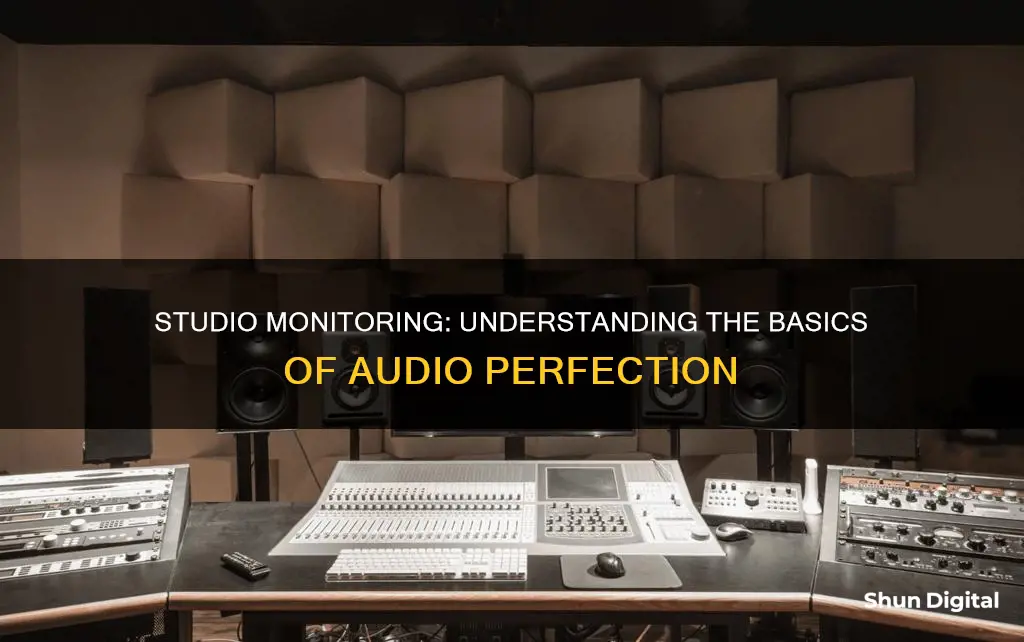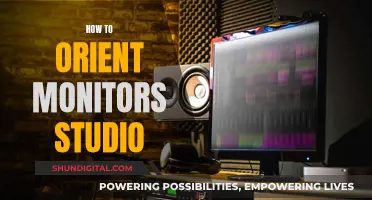
Studio monitors are loudspeakers designed for professional audio production applications. They are used in recording studios, filmmaking, television studios, radio studios, and home studios. Studio monitors are designed to produce a flat frequency response, meaning they do not emphasise or de-emphasise particular frequencies, providing an accurate reproduction of the source audio. This is crucial for audio engineers who need to make precise adjustments to the mix. Studio monitors come in various sizes and can be active (with built-in amplifiers) or passive (requiring external amplification). They are typically used for near-field, mid-field, or far-field applications, depending on the listening distance and environment.
| Characteristics | Values |
|---|---|
| Purpose | Critical listening, recording, mixing, mastering, playback |
| Use cases | Recording studios, filmmaking, television studios, radio studios, project or home studios |
| Sound | Flat, precise, uncoloured, transparent, linear phase and frequency response |
| Design | Robust, compact, mid-field, far-field, near-field |
| Components | Tweeter, woofer, subwoofer, crossover, amplifier |
| Brands | Yamaha, Mackie, KRK, JBL, Genelec, Neumann, Quested, M & K, Amphion Loudspeakers, ADAM, Dynaudio, Focal/JM Labs, PMC, surrounTec, Tannoy |
What You'll Learn
- Studio monitors are loudspeakers designed for professional audio production
- Studio monitors aim for a flat frequency response to reproduce audio without any coloration
- Studio monitors are used for critical listening to identify sonic imperfections
- Studio monitors are either active or passive
- Studio monitors are used for recording, mixing and mastering

Studio monitors are loudspeakers designed for professional audio production
The main difference between studio monitors and basic speakers is the attention to precision. Studio monitors are built to produce a very flat frequency response, allowing sound engineers to hear tiny details in a mix. This flat response assists engineers in mixing, ensuring they do not add additional bass, treble, or other frequencies. Studio monitors come in various sizes, shapes, colours, and price points. They can be "near-field" or "far-field" monitors. Near-field monitors are designed for listening at close distances, typically placed on stands or desks. Far-field monitors, on the other hand, are usually wall-mounted and are used to fill a room with sound.
Studio monitors are also more physically robust than home hi-fi loudspeakers. They are designed to handle high volumes and sudden sound bursts that may occur in the studio when playing back unmastered mixes. Studio monitors are essential for critical listening, allowing producers and engineers to identify and fix sonic imperfections. They are used in the recording, mixing, and mastering processes, helping to create a high-quality sound space.
In the early years of the recording industry, studio monitors were primarily used to check for noise interference and technical issues. However, over time, their role evolved, and they became crucial for artistic evaluations as well. The first high-quality loudspeaker designed specifically as a studio monitor was the Altec Lansing Duplex 604, introduced in 1944. It became the industry standard for the next 25 years, with various model modifications.
SPM Performance Monitoring: Maximizing IT Efficiency
You may want to see also

Studio monitors aim for a flat frequency response to reproduce audio without any coloration
Studio monitors are loudspeakers designed for professional audio production applications. They are used in recording studios, filmmaking, television studios, radio studios, and home studios. Studio monitors are designed to produce a flat frequency response, meaning they exhibit minimal emphasis or de-emphasis of particular frequencies. This results in an accurate reproduction of the tonal qualities of the source audio, without any coloration or distortion in the sound-stage perspective for stereo recordings.
The flat frequency response of studio monitors is achieved through a linear phase and frequency response. This ensures that the loudspeaker does not artificially boost or de-emphasize certain frequencies, such as bass, treble, or other frequencies. By avoiding these resonances, studio monitors provide an accurate reproduction of the audio signal, allowing producers and audio engineers to hear precisely what they are mixing. This is crucial as speaker/monitor errors can cause mixing errors, such as adding too much bass to compensate for poor bass reproduction.
The design of studio monitors focuses on precision and transparency. They are constructed to be physically robust, coping with high volumes and sudden sound bursts that may occur in the studio when playing back unmastered mixes. Studio monitors are also designed for near-field, mid-field, or far-field use. Near-field monitors are compact speakers placed close to the listener, reducing the impact of room acoustics and ensuring most of the sound heard is coming directly from the speaker. Mid-field and far-field monitors, on the other hand, are larger and suited for bigger studio environments, allowing accurate stereo imaging for multiple persons.
The flat frequency response of studio monitors is essential for accurate audio reproduction, ensuring that the audio signal is reproduced faithfully without any coloration. This feature is particularly important for applications such as recording, mixing, mastering, and critical listening, where sonic imperfections need to be identified and fixed. Studio monitors are designed to sound "bad" in the sense that they reveal these imperfections, allowing producers and engineers to make informed decisions during the production process.
Sending Balanced Signals: Studio Monitor Setup Guide
You may want to see also

Studio monitors are used for critical listening to identify sonic imperfections
Studio monitors are loudspeakers designed for professional audio production applications. They are used in recording studios, filmmaking, television studios, radio studios, and home studios. Studio monitors are built to produce a very flat frequency response, meaning they do not artificially boost bass, treble, or other frequencies. This is because they are designed for critical listening, allowing users to identify and fix sonic imperfections.
The flat frequency response of studio monitors helps sound engineers hear tiny details in a mix. A mix might sound great on headphones, but studio monitors ensure that the sound engineer is not adding additional bass, treble, or other frequencies. This is especially important when mixing tracks, as speaker errors can cause mixing errors. For example, if a speaker does not reproduce bass well, the user might compensate by adding more bass to the mix. When someone listens to this mix on a good system, there will be too much bass. Studio monitors help to avoid this issue by providing an accurate reproduction of the original audio signal.
Studio monitors come in various sizes, shapes, colours, and price points. They can be active or passive. Passive monitors require an external amplifier, while active monitors have built-in amplification. Active monitors are more common in studio settings, as they provide a more precise sound. Studio monitors can also be near-field or far-field. Near-field monitors are designed for listening at close distances, typically placed on stands or desks. Far-field monitors are usually wall-mounted and are used in larger studio environments.
In addition to studio monitors, subwoofers are used to hear the full range of frequencies in a mix. However, subwoofers are typically only used at the end of the mixing process, as they can be dangerous during mixing due to the easy addition of treble and bass. Studio monitors are an essential tool for anyone involved in professional audio production, ensuring an accurate and precise reproduction of audio signals.
Extending Display Sizes: Multiple Monitors, One Large Display
You may want to see also

Studio monitors are either active or passive
Studio monitors are a type of loudspeaker designed for professional audio production applications. They are used in recording studios, filmmaking, television studios, radio studios, and home studios. Studio monitors are designed to produce a flat frequency response, meaning they exhibit minimal emphasis or de-emphasis of particular frequencies, giving an accurate reproduction of the source audio.
Studio monitors can be either active or passive. Active monitors have built-in power amplifiers, while passive monitors require external power from a dedicated standalone amplifier. Active monitors tend to have multiple power amplifiers in one unit, allowing individual power to the woofer (bass), midrange, and tweeter (treble) cones, resulting in a more precise sound. Passive monitors, on the other hand, require an external power amplifier and are typically connected to a central amplifier.
The choice between active and passive studio monitors depends on the specific application and user preferences. Active monitors offer convenience and streamlined design, while passive monitors provide flexibility and the ability to customise the setup.
In addition to the active and passive distinction, studio monitors can also be categorised as near-field, mid-field, or far-field. Near-field monitors are designed for close-range listening, typically placed on stands or desks, and are commonly used in home studios. Mid-field and far-field monitors are larger in size and are suited for bigger studio environments, such as film scoring studios.
Connecting Your Wii U to an HDMI Monitor
You may want to see also

Studio monitors are used for recording, mixing and mastering
Studio monitors are an essential component of the recording, mixing, and mastering process. They are designed to provide a flat frequency response, ensuring that the audio signal is reproduced faithfully without artificially boosting bass, treble, or other frequencies. This accuracy in sound reproduction is crucial for producers and audio engineers, allowing them to make informed decisions during the recording and mixing stages.
During the recording process, studio monitors enable producers to hear the audio signal as it is being captured. This direct feedback helps producers identify any noise interference or technical issues that may impact the quality of the recording. With studio monitors, producers can ensure that the audio signal is accurately reproduced, capturing the performance as intended.
In the mixing stage, studio monitors become even more critical. Mixing involves balancing and adjusting various elements of the recorded tracks, such as volume levels, panning, and audio effects. Studio monitors provide an honest representation of the mix, allowing engineers to make precise adjustments. The flat frequency response of studio monitors ensures that engineers can hear subtle details and make informed decisions without the speakers colouring the sound.
Mastering is the final step in the audio production process, where the overall sound of the recording is optimised. Studio monitors are vital in this stage as they enable audio engineers to assess the aesthetic merits of the final product and make any necessary adjustments. By using studio monitors, engineers can ensure that the recording is reasonably free from technical defects and that the desired sound is achieved.
Studio monitors are designed with specific features to support their role in the recording, mixing, and mastering process. They often have built-in power amplifiers, known as active monitors, providing individual power to the woofer, midrange, and tweeter cones for a more precise sound. Additionally, studio monitors typically include crossovers, which ensure that different frequencies are directed to the appropriate driver, enhancing clarity and precision.
The physical design of studio monitors also sets them apart from regular speakers. They are often designed for near-field use, meaning they are placed close to the listener to minimise the influence of the room's acoustics. This results in a direct and immediate sound, free from natural reverberations, providing an accurate impression of the mix.
Setting Up Yamaha HS5 Monitors: A Beginner's Guide
You may want to see also
Frequently asked questions
Studio monitoring is the process of using studio monitors, or loudspeakers, to assess the aesthetic merits of a programme and tailor the balance through audio mixing and mastering to achieve the desired result. Studio monitors are designed to provide a flat frequency response so that the audio signal is reproduced faithfully.
Studio monitors are designed to sound "bad" in the sense that they are meant to be used for critical listening, allowing users to pick out sonic imperfections so they can be fixed. Regular speakers, on the other hand, are meant to sound "good" and are designed to enhance the sound.
Active speakers are powered, meaning they have built-in power amplifiers, while passive speakers require external power from a dedicated standalone amplifier.
Near-field monitors are designed for listening at close distances, typically a few feet away, to provide a clear and immediate sound. Mid-field monitors are a few metres away from the listener, while far-field monitors are non-directional and aimed to fill a room.
Popular studio monitor brands include Yamaha, Mackie, KRK, Adam, Alesis, Dynaudio, Behringer, Event, Focal, Fostex, Genelec, JBL, Kurzweil, M-Audio, Tannoy, Tascam, and more.







